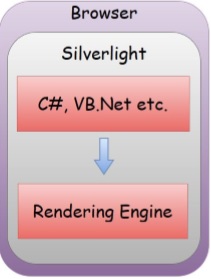
- Silverlight - Home
- Silverlight - Overview
- Silverlight - Environment Setup
- Silverlight - Getting Started
- Silverlight - XAML Overview
- Silverlight - Project Types
- Silverlight - Fixed Layouts
- Silverlight - Dynamic Layout
- Constrained vs. Unconstrained
- Silverlight - CSS
- Silverlight - Controls
- Silverlight - Buttons
- Silverlight - Content Model
- Silverlight - ListBox
- Silverlight - Templates
- Silverlight - Visual State
- Silverlight - Data Binding
- Silverlight - Browser Integration
- Silverlight - Out-of-Browser
- Silverlight - Applications, Resources
- Silverlight - File Access
- Silverlight - View Model
- Silverlight - Input Handling
- Silverlight - Isolated Storage
- Silverlight - Text
- Silverlight - Animation
- Silverlight - Video and Audio
- Silverlight - Printing
Silverlight - Overview
Welcome to Silverlight tutorials. Silverlight is a platform for building rich internet applications. This tutorial will explain the concepts behind Silverlight, and will show you how to build it into your web applications. After completing it, you will have a better understanding of Silverlight applications using XAML and C#.
What is Silverlight
Silverlight is a browser plug-in, designed for building rich internet applications; applications that run in the browser like normal web applications, but which try to advance the user interface beyond where HTML can go. For example,
Silverlight is a framework for building rich, browser-hosted applications that run on a variety of operating systems.
It can also co-exist with HTML. Therefore, Silverlight can enhance an existing web application.
Silverlight works its magic through a browser plug-in. When you surf to a web page that includes Silverlight content, this browser plug-in runs, executes the code, and renders that content in a specifically designated region of the page.
The important part is that the Silverlight plug-in provides a richer environment than the traditional blend of HTML and JavaScript that powers ordinary web pages.
You can create Silverlight pages that play video, have hardware accelerated 3D graphics, and use vector animations.
From a developer's perspective, the most interesting feature of Silverlight is that it brings the .NET Framework programming model to the client side of your web applications.

Silverlight is designed to run inside the web pages, so it can run as a browser plugin. It provides graphical services for rendering bitmaps, vector graphics, highdefinition video, and animations.
You can write in C#, or Visual Basic .NET, and use the .NET Framework class library features on the code that runs in the web browser.
Silverlight user interfaces, themselves use a very similar model to Windows Presentation Foundation(WPF), which is the user interface framework in the full desktop .NET Framework.
If you know WPF, Silverlight is easy to learn. Silverlight is a much smaller download than .NET. It is roughly a tenth of the size, so only a subset of the class library is present, and various implications have been made to WPF's model.
Despite the reduced scale, experienced .NET developers will feel instantly at home in Silverlight.
Platforms and Browsers
The platforms and browsers supported by Silverlight are −
Windows
Silverlight supports Windows, as you would expect of a Microsoft product. It requires Windows XP Service Pack 2 at least or recent versions of Windows.
The older versions are not fully supported. For example, Silverlight will not run at all on Windows ME, and Windows 2000 has limited support.
As for the browsers, Silverlight supports Microsoft's own Internet Explorer, of course, and it supports Firefox, and Google Chrome version 4.
Broadly, Silverlight supports the common web browser plug-in API. It works in a wider range of browsers than the officially supported list.
Mac
Silverlight supports Mac OS10, although Silverlight version 2 or later only runs on Intel-based Macs.
On modern Macs, both Firefox and Safari are supported.
Linux
Microsoft's own Silverlight plug-in does not run on Linux, but the Mono open source project has an offshoot called Moonlight, which is a Silverlight compatible plug-in that runs on Linux.
Moonlight runs in Firefox, and interestingly has always been able to run in Standalone mode.
One of the reasons the Mono project decided to build Moonlight in the first place is that they thought Silverlight would be a useful technology for building user interface widgets that run on the desktop.